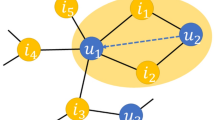Abstract
Recently, because of the remarkable performance in alleviating the data sparseness problem in recommender systems, Graph Convolutional (Neural) Networks (GCNs) have drawn wide attention as an effective recommendation approach. By modeling the user-item interaction graph, GCN iteratively aggregates neighboring nodes into embeddings of different depths according to the importance of each node. However, the existing GCN-based methods face the common issues that, they do not consider the node information and graph structure during aggregating nodes, such that they cannot assign reasonable weights to the neighboring nodes. Additionally, they ignore the differences in node types in the user-item interaction graph and thus, cannot explore the complex relationship between users and items, resulting in a suboptimal result. To solve these problems, a novel GCN-based framework called RNT-GCN is proposed in this paper. RNT-GCN integrates the structure of the graph and node information to assign reasonable importance to different nodes. In addition, RNT-GCN refines the node types, such that the heterogeneous properties of the user-item interaction graph can be better preserved, and the collaborative information of users and items can be effectively extracted. Extensive experiments prove the RNT-GCN achieved significant performance compared to SOTA methods.
W. He and G. Sun—Contributed equally to this research.
Access this chapter
Tax calculation will be finalised at checkout
Purchases are for personal use only
Similar content being viewed by others
References
van den Berg, R., Kipf, T.N., Welling, M.: Graph Convolutional Matrix Completion (2018)
Chen, H., et al.: Graph neural transport networks with non-local attentions for recommender systems. In: WWW, pp. 1955–1964 (2022)
Chen, L., et al.: Revisiting graph based collaborative filtering: a linear residual graph convolutional network approach. In: AAAI, pp. 27–34 (2020)
Covington, P., Adams, J., Sargin., E.: Deep neural networks for YouTube recommendations. In: RecSys, pp. 191–198 (2016)
Glorot, X., Bengio, Y.: Understanding the difficulty of training deep feedforward neural networks. In: AISTATS, pp. 249–256 (2010)
Gori, M., Pucci, A.: ItemRank: a random-walk based scoring algorithm for recommender engines". In: IJCAI, pp. 2766–2771 (2007)
He, X., et al.: LightGCN: simplifying and powering graph convolution network for recommendation. In: SIGIR, pp. 639–648 (2020)
He, X., et al.: Neural Collaborative Filtering. In: WWW, pp. 173–182 (2017)
He, X., et al.: TriRank: review-aware explainable recommendation by modeling aspects. In: CIKM, pp. 1661–1670 (2015)
Kingma, D.P., Ba, J.: Adam: a method for stochastic optimization. In: ICLR (2015)
Kipf, T.N., Welling, M.: Semi-supervised classification with graph convolutional networks. In: ICLR (2017)
Koren, Y., Bell, R.M., Volinsky, C.: Matrix factorization techniques for recommender systems. Computer 8, 30–37 (2009)
Liu, F., et al.: Interest-aware message-passing GCN for recommendation. In: WWW, pp. 1296–1305 (2021)
Mao, K., et al.: UltraGCN: ultra simplification of graph convolutional networks for recommendation. In: CIKM, pp. 1253–1262 (2021)
Mehta, N., Pacheco, M.L., Goldwasser, D.: Tackling fake news detection by continually improving social context representations using graph neural networks. In: ACL, pp. 1363–1380 (2022)
Rendle, S., et al.: BPR: bayesian personalized ranking from implicit feedback. In: UAI, pp. 452–461 (2009)
Sun, J., et al.: Neighbor interaction aware graph convolution networks for recommendation. In: SIGIR, pp. 1289–1298 (2020)
Sun, J., et al.: Separated graph neural networks for recommendation systems. In: IEEE TII, pp. 382–393 (2023)
Velickovic, P., et al.: Graph attention networks. In: ICLR (2018)
Wang, X., et al.: Disentangled graph collaborative filtering. In: SIGIR, pp. 1001–1010 (2020)
Wang, X., et al.: KGAT: knowledge graph attention network for recommendation. In: KDD, pp. 950–958 (2019)
Wang, X., et al.: Neural graph collaborative filtering. In: SIGIR, pp. 165–174 (2019)
Xu, K., et al.: Representation learning on graphs with jumping knowledge networks. In: ICML, pp. 5449–5458 (2018)
Zhang, Y., et al.: Geometric disentangled collaborative filtering. In: SIGIR 2022, Madrid, Spain, pp. 80–90 (2022)
Acknowledgement
This work was supported by Shanghai Science and Technology Commission (No. 22YF1401100), Fundamental Research Funds for the Central Universities (No. 22D111210, 22D111207), and National Science Fund for Young Scholars (No. 62202095).
Author information
Authors and Affiliations
Corresponding author
Editor information
Editors and Affiliations
Rights and permissions
Copyright information
© 2023 The Author(s), under exclusive license to Springer Nature Switzerland AG
About this paper
Cite this paper
He, W., Sun, G., Lu, J., Fang, X., Liu, G., Yang, J. (2023). Refined Node Type Graph Convolutional Network for Recommendation. In: Yang, X., et al. Advanced Data Mining and Applications. ADMA 2023. Lecture Notes in Computer Science(), vol 14176. Springer, Cham. https://doi.org/10.1007/978-3-031-46661-8_7
Download citation
DOI: https://doi.org/10.1007/978-3-031-46661-8_7
Published:
Publisher Name: Springer, Cham
Print ISBN: 978-3-031-46660-1
Online ISBN: 978-3-031-46661-8
eBook Packages: Computer ScienceComputer Science (R0)




